Reading time: 9 min
There was once an old goat who had seven little ones, and was as fond of them as ever mother was of her children. One day she had to go into the wood to fetch food for them, so she called them all round her. „Dear children,“ said she, „I am going out into the wood; and while I am gone, be on your guard against the wolf, for if he were once to get inside he would eat you up, skin, bones, and all. The wretch often disguises himself, but he may always be known by his hoarse voice and black paws.“
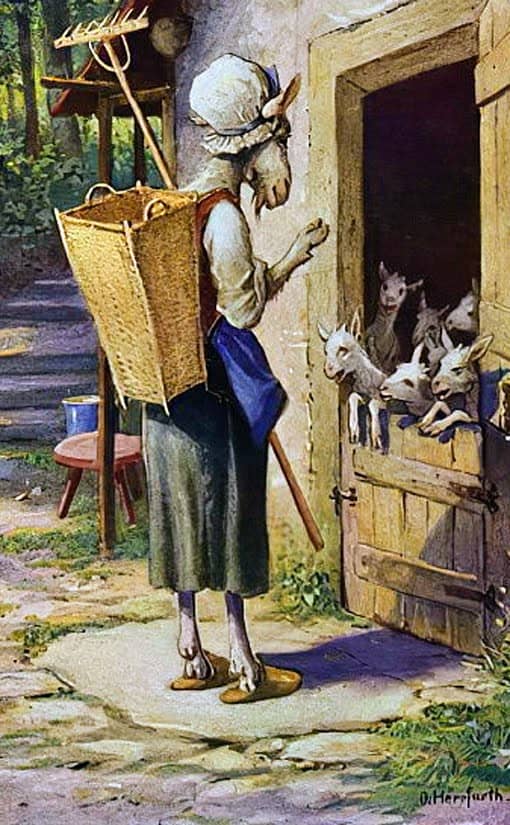 Image: Oskar Herrfurth (1862-1934)
Image: Oskar Herrfurth (1862-1934)„Dear mother,“ answered the kids, „you need not be afraid, we will take good care of ourselves.“ And the mother bleated good-bye, and went on her way with an easy mind. It was not long before some one came knocking at the house-door, and crying out: „Open the door, my dear children, your mother is come back, and has brought each of you something.“ But the little kids knew it was the wolf by the hoarse voice.
„We will not open the door,“ cried they; „you are not our mother, she has a delicate and sweet voice, and your voice is hoarse. You must be the wolf.“ Then off went the wolf to a shop and bought a big lump of chalk, and ate it up to make his voice soft. And then he came back, knocked at the house-door, and cried: „Open the door, my dear children, your mother is here, and has brought each of you something.“
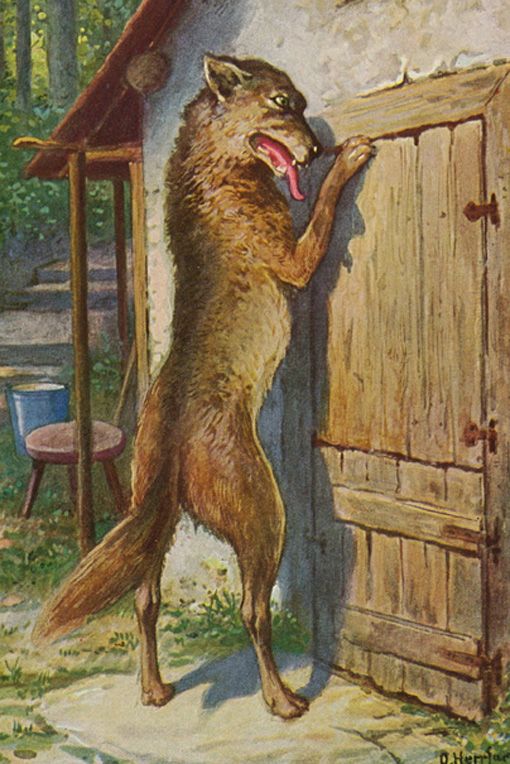 Image: Oskar Herrfurth (1862-1934)
Image: Oskar Herrfurth (1862-1934)But the wolf had put up his black paws against the window, and the kids seeing this, cried out, „We will not open the door; our mother has no black paws like you. You must be the wolf.“ The wolf then ran to a baker. „Baker,“ said he, „I am hurt in the foot; pray spread some dough over the place.“ And when the baker had plastered his feet, he ran to the miller. „Miller,“ said he, „strew me some white meal over my paws.“ But the miller refused, thinking the wolf must be meaning harm to some one. „If you don’t do it,“ cried the wolf, „I’ll eat you up!“ And the miller was afraid and did as he was told. And that just shows what men are.
And now came the rogue the third time to the door and knocked. „Open, children!“ cried he. „Your dear mother has come home, and brought you each something from the wood.“ – „First show us your paws,“ said the kids, „so that we may know if you are really our mother or not.“ And he put up his paws against the window, and when they saw that they were white, all seemed right, and they opened the door.
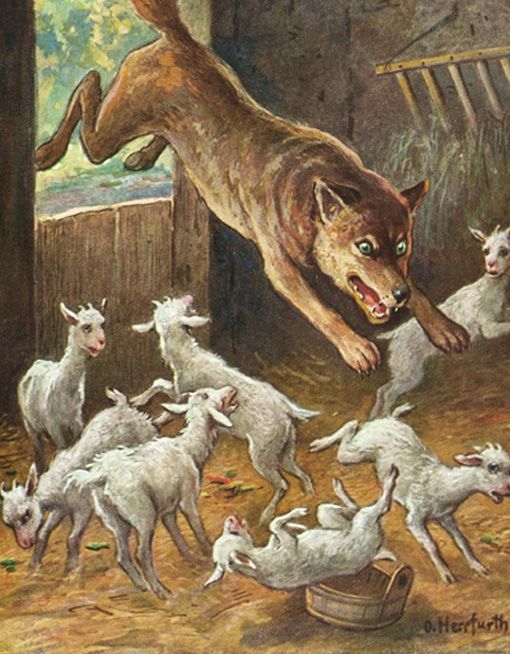 Image: Oskar Herrfurth (1862-1934)
Image: Oskar Herrfurth (1862-1934)And when he was inside they saw it was the wolf, and they were terrified and tried to hide themselves. One ran under the table, the second got into the bed, the third into the oven, the fourth in the kitchen, the fifth in the cupboard, the sixth under the sink, the seventh in the clock-case. But the wolf found them all, and gave them short shrift. One after the other he swallowed down, all but the youngest, who was hid in the clock-case. And so the wolf, having got what he wanted, strolled forth into the green meadows, and laying himself down under a tree, he fell asleep.
Not long after, the mother goat came back from the wood; and, oh! what a sight met her eyes! the door was standing wide open, table, chairs, and stools, all thrown about, dishes broken, quilt and pillows torn off the bed. She sought her children, they were nowhere to be found. She called to each of them by name, but nobody answered, until she came to the name of the youngest.
„Here I am, mother,“ a little voice cried, „here, in the clock case.“ And so she helped him out, and heard how the wolf had come, and eaten all the rest. And you may think how she cried for the loss of her dear children. At last in her grief she wandered out of doors, and the youngest kid with her; and when they came into the meadow, there they saw the wolf lying under a tree, and snoring so that the branches shook.
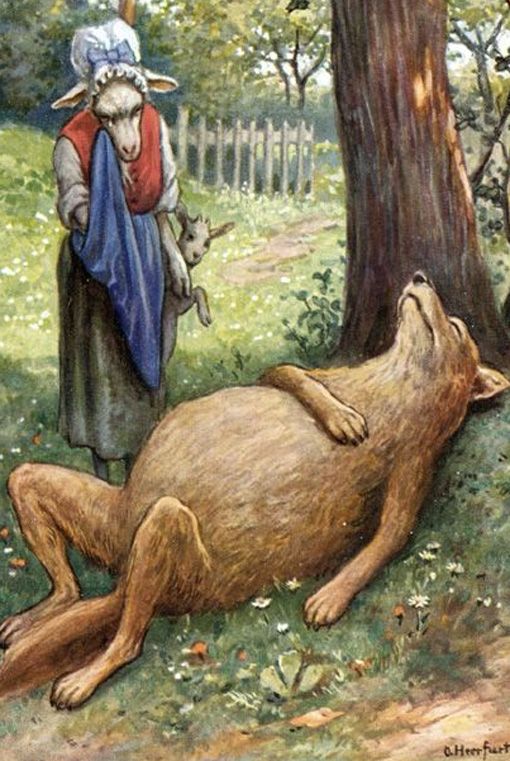 Image: Oskar Herrfurth (1862-1934)
Image: Oskar Herrfurth (1862-1934)The mother goat looked at him carefully on all sides and she noticed how something inside his body was moving and struggling. Dear me! thought she, can it be that my poor children that he devoured for his evening meal are still alive? And she sent the little kid back to the house for a pair of shears, and needle, and thread. Then she cut the wolf’s body open, and no sooner had she made one snip than out came the head of one of the kids, and then another snip, and then one after the other the six little kids all jumped out alive and well, for in his greediness the rogue had swallowed them down whole.
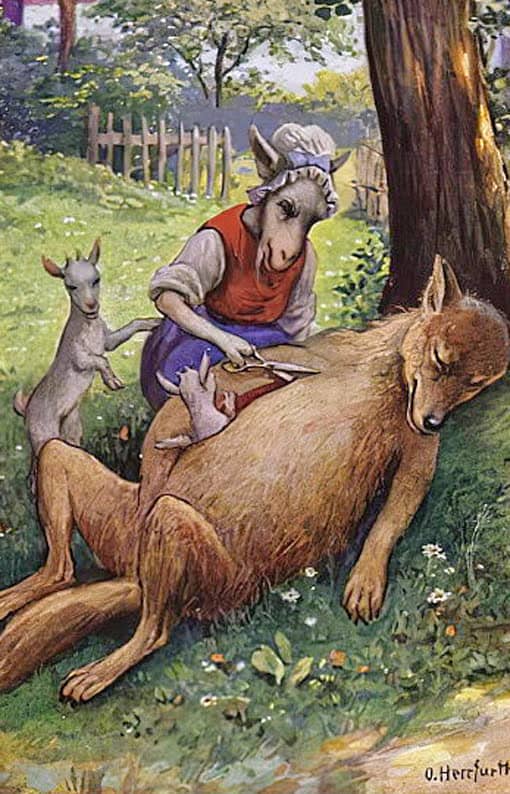 Image: Oskar Herrfurth (1862-1934)
Image: Oskar Herrfurth (1862-1934)How delightful this was! so they comforted their dear mother and hopped about like tailors at a wedding. „Now fetch some good hard stones,“ said the mother, „and we will fill his body with them, as he lies asleep.“ And so they fetched some in all haste, and put them inside him, and the mother sewed him up so quickly again that he was none the wiser. When the wolf at last awoke, and got up, the stones inside him made him feel very thirsty, and as he was going to the brook to drink, they struck and rattled one against another. And so he cried out:
„What is this I feel inside me.
Knocking hard against my bones?
How should such a thing betide me!
They were kids, and now they’re stones.“
So he came to the brook, and stooped to drink, but the heavy stones weighed him down, so he fell over into the water and was drowned. And when the seven little kids saw it they came up running. „The wolf is dead, the wolf is dead!“
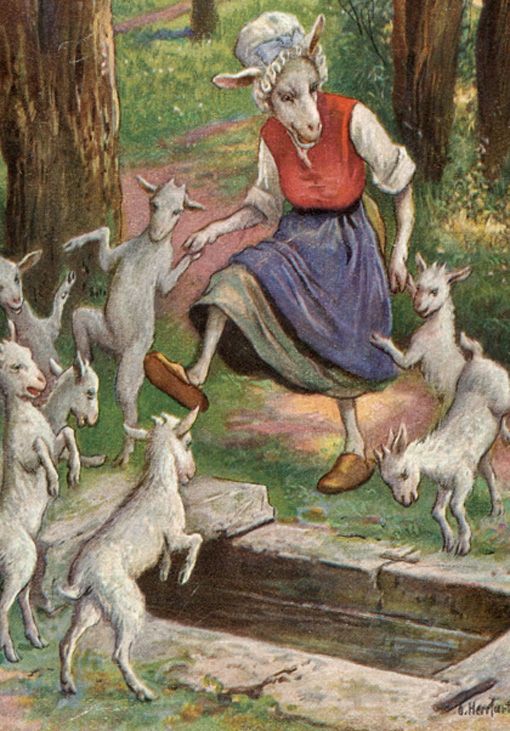
They cried, and taking hands, they danced with their mother all about the place.
 Learn languages. Double-tap on a word.Learn languages in context with Childstories.org and Deepl.com.
Learn languages. Double-tap on a word.Learn languages in context with Childstories.org and Deepl.com.Backgrounds
Interpretations
Adaptions
Summary
Abstract
Linguistics
„The Wolf and the Seven Young Goats“ is a German fairy tale collected by the Brothers Grimm, who were responsible for publishing a vast collection of fairy tales that continue to captivate readers of all ages. The book was first published in 1812, with many revised editions following. The Brothers Grimm were German scholars and linguists who sought to preserve the cultural heritage of their country by collecting and publishing traditional folktales. The tale is also known as „Der Wolf und die sieben jungen Geißlein“ in German.
The story revolves around a mother goat and her seven young kids who are left alone at home while she goes out to gather food. The mother goat warns her children not to open the door for anyone other than her, especially not the cunning wolf. Despite their mother’s warning, the kids are tricked by the wolf and fall victim to his deceit, except for the youngest one who hides in the clock case. When the mother goat returns, she discovers the situation and sets out to rescue her children from the wolf’s belly with the help of the youngest kid.
Like many other Grimm fairy tales, „The Wolf and the Seven Young Goats“ has its roots in oral storytelling traditions that date back centuries. The tale likely evolved from various European folktales that emphasized caution, cunning, and the importance of listening to the wisdom of elders. The story shares similarities with other popular fairy tales, such as „Little Red Riding Hood“ and „The Three Little Pigs,“ which also feature wolves as the primary antagonist. These tales often serve as cautionary stories for children, warning them of the dangers of trusting strangers and the importance of following the advice of their parents or guardians.
The tale itself is classified as Aarne-Thompson-Uther (ATU) Type 123, which consists of stories featuring a mother who leaves her children home alone, and a villain who disguises themselves to enter the house. This classification system, developed by Finnish folklorist Antti Aarne and later expanded upon by American folklorist Stith Thompson and German folklorist Hans-Jörg Uther, is used to categorize and analyze folklore from different cultures. The story of „The Wolf and the Seven Young Goats“ shares similarities with other popular fairy tales, such as „Little Red Riding Hood“ and „The Three Little Pigs,“ where cunning wolves serve as antagonists. The wolf’s deceitful tactics and the importance of vigilance and obedience are recurring themes in these tales.
„The Wolf and the Seven Young Goats“ remains a classic fairy tale enjoyed by readers worldwide. Its themes of caution, cunning, and the importance of heeding advice from elders continue to resonate with audiences today, reminding children and adults alike of the importance of these virtues. Over the years, the story has been adapted and retold in various forms, including books, plays, and animated films. These adaptations sometimes take creative liberties with the original story, but the central themes and characters generally remain the same.
„The Wolf and the Seven Young Goats“ is a classic fairy tale that has been interpreted in various ways over the years. Here are some common interpretations of the story.
Obedience and listening to elders: One of the central themes in the story is the importance of listening to the advice of one’s parents or guardians. The mother goat warns her children not to open the door to strangers, but they fail to heed her warning, resulting in dire consequences. The story serves as a reminder to children to obey their parents and trust their wisdom.
Caution and awareness of danger: The tale highlights the importance of being cautious and aware of potential dangers. The young goats must learn to recognize the wolf and be careful not to fall for his tricks. This theme encourages children to develop a sense of caution and awareness in their own lives, particularly when dealing with strangers or unfamiliar situations.
Cunning and resourcefulness: The story also emphasizes the value of being cunning and resourceful in the face of danger. The youngest goat is able to escape the wolf’s clutches by hiding in the clock case and later helps the mother goat rescue her siblings. This theme teaches children the importance of using their intelligence and resourcefulness to overcome challenges and protect themselves and their loved ones.
The triumph of good over evil: Like many fairy tales, „The Wolf and the Seven Young Goats“ ultimately sees good triumphing over evil. The mother goat and her youngest kid are able to outsmart the wolf and save the other goats, teaching children that good can prevail even in the face of adversity.
The dangers of deception: The wolf in the story uses deception and trickery to prey on the young goats. This theme serves as a cautionary reminder to children to be wary of those who may try to deceive them and to always trust their instincts when something feels amiss.
Importance of obedience and vigilance: The mother goat warns her children about the dangers of the wolf and advises them to be cautious. The children’s obedience and vigilance initially protect them from the wolf’s deception. However, when they are deceived by the wolf’s disguise, the consequences are dire. This highlights the importance of staying alert and listening to the advice of those who care for us.
Deception and appearances: The wolf uses disguises and deception to achieve his goal. He changes his voice and his appearance to trick the children into letting him in. This serves as a reminder to be cautious when dealing with strangers or situations that may seem harmless at first glance. Appearances can be deceiving, and it’s essential to look beyond the surface.
The power of family and unity: The mother goat’s love for her children drives her to rescue them from the wolf. The youngest kid, who survives, helps his mother in this mission. The family works together to overcome adversity, emphasizing the importance of family bonds and unity.
Justice and retribution: The wolf, in his greed and cruelty, devours the six young goats. However, he ultimately faces the consequences of his actions when he is weighed down by the stones and drowns. This outcome can be seen as a form of justice, teaching the lesson that wrongdoing will eventually be punished.
Resilience and hope: The mother goat and her youngest child show resilience and hope in the face of tragedy. They work together to save the other children and ultimately defeat the wolf. This demonstrates that even in the darkest situations, hope and perseverance can lead to a positive outcome.
Overall, „The Wolf and the Seven Young Goats“ is a multifaceted tale that imparts valuable lessons about obedience, caution, cunning, and the triumph of good over evil. These themes continue to resonate with readers of all ages, making the story a beloved classic in the world of fairy tales.
„The Wolf and the Seven Young Goats“ is a German fairy tale collected by the Brothers Grimm, Jacob and Wilhelm, in their famous book „Grimms‘ Fairy Tales“ (originally titled „Kinder- und Hausmärchen“). „The Wolf and the Seven Young Goats“ has inspired various adaptations and retellings in different forms of media, including literature, film, and television. Here are a few examples.
Literature: „The Jolly Barnyard“ (1950) by Annie North Bedford: This Little Golden Book, although not a direct adaptation, features a similar storyline where farm animals must outsmart a cunning fox who tries to prey on them. The themes of caution and resourcefulness are similar to those found in „The Wolf and the Seven Young Goats.“ There are numerous children’s books that adapt the story, including „The Wolf and the Seven Kids“ by Anne Grahame Johnstone and „The Wolf and the Seven Little Kids“ by Helen Ward.
Animation: „Silly Symphonies – The Wolf and the Kids“ (1932): This animated short film by Walt Disney is a loose adaptation of the fairy tale. The film presents the story with the classic Disney touch, using humor and music to engage audiences while maintaining the original themes of the story. The story has been adapted into several animated films, including the 1935 Soviet film „The Wolf and the Seven Young Kids“ and the 1957 Disney short „The Littlest Outlaw.“
Television: „Simsala Grimm“ (1999-2010): This German animated television series retells various Grimm fairy tales, including „The Wolf and the Seven Young Goats“ in Season 1, Episode 9. The show stays true to the original story while presenting it in a modern, animated format for children.
Theater and Puppetry: Various puppet shows and theatrical performances have been staged over the years, adapting „The Wolf and the Seven Young Goats“ for live audiences. These adaptations often use humor and audience interaction to bring the story to life while maintaining the original themes and lessons. The story has been adapted into puppet shows, including the Czech puppetry production „The Wolf and the Seven Young Goats“ by Josef Skupa.
Interactive Media: „Grimm’s Fairy Tales – The Wolf and the Seven Little Goats“ (2013): This interactive storybook app allows children to experience the story in a new way, with animated illustrations, narration, and interactive elements. The app stays true to the original story while engaging young readers through technology.
Operas and Ballets: The story has been adapted into several operas and ballets, including the 1914 opera „Der Wolf und die sieben jungen Geißlein“ by Franz Schreker and the 1937 ballet „Le Loup“ by Serge Prokofiev.
Video Games: The story has also been adapted into video games, including the 2017 puzzle game „The Wolf and the Seven Young Goats“ by SmartGames.
Although „The Wolf and the Seven Young Goats“ might not have as many adaptations as some other Grimm fairy tales, its themes of caution, resourcefulness, and the importance of listening to elders continue to inspire storytellers across various media. The story’s timeless lessons remain relevant and continue to engage audiences of all ages. These are just a few examples of the adaptations of „The Wolf and the Seven Young Goats“ from the Brothers Grimm. The enduring popularity of the story is a testament to its timeless themes and memorable characters.
„The Wolf and the Seven Young Goats“ is a classic fairy tale that tells the story of a mother goat and her seven young kids. One day, the mother goat needs to go out to gather food for her family, so she leaves her children at home, warning them not to open the door to anyone, especially the cunning wolf. While the mother goat is away, the wolf comes to the house and tries to trick the young goats into letting him in by disguising his voice. The young goats recognize the wolf’s deep voice and refuse to open the door.
The wolf goes to a nearby mill and eats chalk to make his voice sound more like the mother goat’s. He returns and tries again, but this time the goats notice his black paws and refuse to let him in once more. The wolf then goes to a baker and has his paws covered in flour, making them appear white. When the wolf returns for the third time, he successfully tricks the young goats, who let him into the house. He proceeds to eat six of the young goats, but the youngest kid manages to hide in a clock case and remains unnoticed. The wolf, satisfied with his meal, leaves the house and falls asleep under a tree nearby.
When the mother goat returns home, she finds the house in disarray and her children missing, except for the youngest, who comes out of the clock case and tells her what happened. The mother goat and her youngest kid go looking for the wolf and find him asleep under a tree. They notice the wolf’s belly moving as the swallowed goats are still alive inside. The mother goat sends her youngest kid to fetch scissors, a needle, and thread. She carefully cuts open the wolf’s belly and frees her other six children, who are unharmed.
They fill the wolf’s belly with stones and sew it back up. When the wolf wakes up, he is thirsty and goes to a nearby well to drink. As he leans over to drink, the weight of the stones causes him to lose his balance and fall into the well, where he drowns. The mother goat and her seven young kids are reunited and live happily ever after, having outsmarted the cunning wolf and learned the importance of caution and listening to their mother’s advice.
„The Wolf and the Seven Young Goats“ is a fairy tale by the Brothers Grimm about a mother goat who must leave her seven children to fetch food. Before leaving, she warns them about the wolf, who can be recognized by his hoarse voice and black paws. The children promise to be cautious, and the mother leaves with peace of mind.
Soon, the wolf arrives and tries to deceive the kids with his voice. The children refuse to open the door as they recognize the wolf’s hoarse voice. The wolf then consumes chalk to soften his voice, but the children still don’t let him in as they see his black paws. The wolf tricks a baker and a miller to cover his paws with dough and white meal, making them appear white. This time, the children are deceived and let the wolf in. In terror, they hide, but the wolf finds and swallows six of them whole, leaving the youngest hidden in a clock case. The wolf, satisfied, falls asleep under a tree.
Upon returning home, the mother goat is distraught at the destruction and loss of her children, but finds the youngest still alive. They discover the sleeping wolf in a meadow, and the mother notices movement inside the wolf. She cuts the wolf open, freeing her six swallowed children, who are still alive. They fill the wolf’s body with stones, and the mother sews him back up. When the wolf awakens and tries to drink from a brook, the weight of the stones causes him to fall in and drown. The children and their mother celebrate the wolf’s death and dance joyfully together.
The fairy tale „The Wolf and the Seven Young Goats“ by the Brothers Grimm is a rich source of linguistic elements and narrative techniques that reflect traditional storytelling practices. Let’s delve into some key aspects of the linguistic analysis of this tale:
Narrative Structure and Style: The story follows a classic fairy tale structure with a clear beginning, middle, and end. It opens with a direct introduction to the characters and setting, quickly establishing the conflict with the warning about the wolf. The use of repetition is a common technique in folk tales, seen here in the wolf’s repeated attempts to deceive the kids. This not only emphasizes the cunning nature of the wolf but also serves as a mnemonic device for oral storytelling.
Characterization: Characters are archetypal, with the mother goat as the caring protector, the wolf as the cunning antagonist, and the kids as innocent victims. Direct speech is used to convey character voices and traits. For instance, the distinction between the mother’s “delicate and sweet voice” and the wolf’s “hoarse voice” is highlighted through dialogue, emphasizing the wolf’s deception.
Moral and Didactic Elements: The tale conveys themes of obedience, caution, and the consequences of deception. It warns against trusting appearances and highlights the importance of vigilance and familial bonds.
Symbolism and Imagery: Symbolism is prevalent, with the wolf representing danger and deceit, and the soft-voiced mother goat symbolizing safety and nurture. Imagery is vivid, especially in describing the chaos after the wolf’s attack and the eventual restoration of order when the kids are rescued.
Use of Direct Address: The narrator uses direct address to engage the audience, particularly in reflecting on human nature (“And that just shows what men are”) and expressing emotions („And you may think how she cried for the loss of her dear children“).
Rhythm and Sound Devices: The story employs rhyme and rhythm, especially in the wolf’s lament (“What is this I feel inside me. Knocking hard against my bones…”), adding a musical quality to the narrative and reinforcing the moral lesson.
Language and Syntax: The language is simple yet vivid, suitable for both children and adults. Sentence structures vary, with a mix of direct speech and narrative exposition, ensuring a dynamic and engaging reading experience.
Cultural and Historical Context: The tale reflects rural and pastoral settings common in Grimm’s fairy tales, emphasizing themes pertinent to the lives of common folk, such as resourcefulness and family unity.
Overall, „The Wolf and the Seven Young Goats“ employs traditional fairy tale conventions to create an engaging and meaningful narrative that imparts moral lessons through its characters and events. The linguistic elements work together to enhance the story’s timeless appeal and instructional value.
Information for scientific analysis
Fairy tale statistics | Value |
|---|---|
| Number | KHM 5 |
| Aarne-Thompson-Uther-Index | ATU Typ 123 |
| Translations | DE, EN, EL, EL, DA, ES, FR, PT, FI, HU, IT, JA, NL, KO, PL, RO, RU, TR, VI, ZH |
| Readability Index by Björnsson | 24.6 |
| Flesch-Reading-Ease Index | 88.5 |
| Flesch–Kincaid Grade-Level | 5.3 |
| Gunning Fog Index | 7.8 |
| Coleman–Liau Index | 7.1 |
| SMOG Index | 6.6 |
| Automated Readability Index | 5.6 |
| Character Count | 5.388 |
| Letter Count | 4.076 |
| Sentence Count | 60 |
| Word Count | 1.049 |
| Average Words per Sentence | 17,48 |
| Words with more than 6 letters | 75 |
| Percentage of long words | 7.1% |
| Number of Syllables | 1.247 |
| Average Syllables per Word | 1,19 |
| Words with three Syllables | 20 |
| Percentage Words with three Syllables | 1.9% |
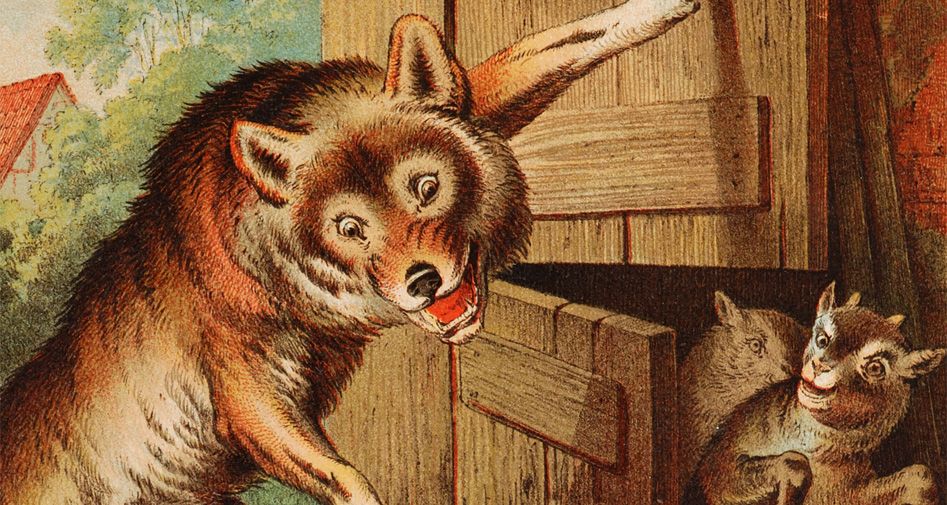
 Facebook
Facebook  Whatsapp
Whatsapp  Messenger
Messenger  Telegram
Telegram Reddit
Reddit















